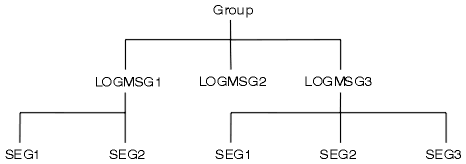- Note:
- The term "message" is used here to denote one item on a queue, such as would be returned by a single MQGET that does not specify MQGMO_COMPLETE_MSG.
Figure 3 shows a group of logical messages:
Logical messages within a group can be used to:
- Ensure ordering (if this is not guaranteed under the circumstances in which the message is transmitted).
- Allow applications to group together similar messages (for example, those that must all be processed by the same server instance).
Each message within a group consists of one physical message, unless it is split into segments. Each message is logically a separate message, and only the GroupId and MsgSeqNumber fields in the MQMD need bear any relationship to other messages in the group. Other fields in the MQMD are independent; some may be identical for all messages in the group whereas others may be different. For example, messages in a group may have different format names, CCSIDs, encodings, and so on.
A segment of a message is identified by the GroupId, MsgSeqNumber, and Offset fields. The Offset field starts at zero for the first segment within a message.
Each segment consists of one physical message that may or may not belong to a group (Figure 4 shows an example of messages within a group). A segment is logically part of a single message, so only the MsgId, Offset, and SegmentFlag fields in the MQMD should differ between separate segments of the same message.
Figure 4 shows a group of logical messages, some of which are segmented:

